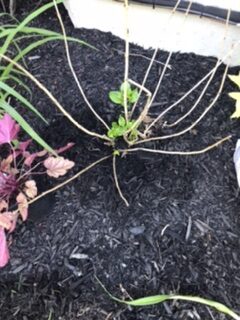
I live in Waterloo, Ontario. I have two hydrangea plants of unknown variety (I think white ball shaped blooms). It has been a few years since they bloomed. Last year I blamed it on the February thaw as I saw that they had budded out and then we went back to hard winter freezes. Both last year and this year I have assumed they were dead and now in early June, I finally see some leaves forming close to the ground. I did not trim them last year. They are part of a large foundation garden. They have eastern morning light.
We are sorry to hear that your hydrangea plants are not doing well. From your description of white ball-shaped blooms, we think that your plants may be Annabelle hydrangea (Hydrangea arborescens ‘Annabelle’) or one of the closely related, newer cultivars. Mophead hydrangeas (Hydrangea macrophylla) do not usually have white flowers.
Annabelle hydrangea is very popular for their gorgeous large blooms; they are also generally vigorous, low maintenance, and disease resistant. They are very reliable bloomers because their flowers bloom on new wood; winter kill or late frost, which can potentially wipe out all the blooms on a mophead hydrangea, have no adverse effect on Annabelle hydrangeas. They are best pruned in the fall or early spring, and the stems can be cut back to ground level to encourage vigorous new growth.
However, your hydrangea plants have not bloomed for years, and are exhibiting such low vigor that you thought they have expired. A struggling plant can be due to disease, pest, incorrect culture, or being unsuited to its site. Have you observed anything unusual about the plants aside from the lack of bloom? Hydrangeas can be susceptible to bud blight, bacterial wilt, leaf spots, mold, rust and powdery mildew. Pests to watch out for include aphids, mites, leaf-rollers and scale. Please take a look at this succinct plant profile to see if your plants are receiving the correct culture (e.g. amount of watering, level of fertilization, etc.) and if it is correctly sited (e.g. hours of sunlight, amount of drainage, etc.).
We wish you the best of luck in your hydrangea’s health and bloom.

